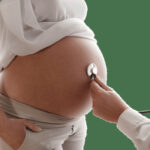Early pregnancy is an exhilarating phase filled with anticipation and wonder, but it can also spark concerns and questions, such as, “Is cramping normal during early pregnancy?” This article delves into this common query to provide clarity and reassurance to expectant mothers. Understanding the physical changes that accompany pregnancy is crucial for women as they navigate this transformative journey.
During early pregnancy, the body undergoes significant adjustments to accommodate the growing fetus, leading to various symptoms like nausea, fatigue, and yes, cramping. Cramping in early pregnancy is typically considered normal as the uterus expands and ligaments stretch to make room for the developing baby. However, it’s essential for women to differentiate between typical cramping and signs of potential complications.
By offering insights into the causes behind cramping during early pregnancy and distinguishing between normal and abnormal discomforts, this article aims to empower women with knowledge to make informed decisions about their health. Additionally, practical tips for managing cramping discomfort and practicing self-care strategies are provided to promote overall well-being during this delicate stage of life.
Understanding the Causes of Cramping in Early Pregnancy
During early pregnancy, the body undergoes various changes to accommodate the growing fetus and prepare for the upcoming months. One common symptom that many women experience during this period is cramping. Understanding the causes behind cramping in early pregnancy can help alleviate concerns and provide reassurance to expectant mothers.
Uterus Expansion
One of the primary reasons for cramping in early pregnancy is the expansion of the uterus. As the fertilized egg implants itself into the uterine lining, the uterus begins to grow to accommodate the developing embryo. This growth process can cause mild cramping sensations as the muscles and ligaments stretch to make room for the growing baby.
Hormonal Changes
Hormonal fluctuations play a significant role in early pregnancy, and these changes can also contribute to cramping. The increased levels of progesterone relax smooth muscle tissue in the body, including those in the uterus. This relaxation can lead to mild cramps as the uterus adapts to its new function of nurturing and protecting the fetus.
Blood Flow
Another factor that may result in cramping during early pregnancy is increased blood flow to the pelvic region. The body redirects more blood supply to support the developing embryo, which can put pressure on blood vessels and surrounding tissues. This increased circulation may lead to occasional cramping as blood flow dynamics shift within the body.
Differentiating Between Normal and Abnormal Cramping
During early pregnancy, it is common for women to experience cramping as their bodies undergo significant changes to accommodate the growing fetus. Understanding what is considered normal cramping during this period can help alleviate some of the worries that expecting mothers may have. Normal cramping in early pregnancy is often described as mild to moderate and may feel similar to menstrual cramps. It is typically caused by the uterus stretching and expanding to make room for the developing baby.
However, it is important for pregnant women to differentiate between normal cramping and abnormal cramping. While some level of discomfort can be expected, severe or persistent cramping accompanied by other symptoms such as heavy bleeding, fever, chills, or dizziness could indicate a more serious issue.
In these cases, it is advisable to seek immediate medical attention to rule out any complications with the pregnancy. Monitoring the frequency and intensity of cramps can also help determine whether they are within the normal range or if further evaluation is necessary.
To ease concerns about cramping during early pregnancy, healthcare providers recommend paying attention to warning signs that may signal a need for medical intervention. Some guidelines include noting the duration of cramps, observing any patterns or triggers that exacerbate the discomfort, and keeping track of any associated symptoms that accompany the cramping episodes.
By being proactive and attentive to changes in their bodies, pregnant women can better navigate their journey through early pregnancy while ensuring both their health and that of their developing baby.
Tips for Managing Cramping Discomfort
Cramping during early pregnancy can often be unsettling for women, but it is important to understand that it is a common occurrence. In this section, we will explore some tips for managing cramping discomfort to help alleviate any uneasiness associated with this symptom.
Gentle Exercises
Engaging in gentle exercises such as prenatal yoga or walking can help relieve cramping by promoting blood flow and easing muscle tension. These activities can also improve overall flexibility and strengthen the muscles, which may contribute to reducing cramping episodes. It is essential to consult with a healthcare provider before starting any exercise routine during pregnancy to ensure safety and suitability.
Rest Positions
Finding comfortable rest positions can also aid in alleviating cramping during early pregnancy. Practicing side sleeping with a pillow between the knees or propping up the legs with cushions while resting can help reduce pressure on the abdomen and provide relief from cramping. Taking short breaks throughout the day to lie down and elevate the legs can also be beneficial in managing discomfort.
Warm Compresses
Applying a warm compress to the lower abdomen or back area where cramping is experienced can help relax muscles and ease tension. The warmth from the compress can increase blood circulation to the affected area, providing soothing relief from cramping. It is essential to ensure that the compress is not too hot to avoid any burns or skin irritation, especially during pregnancy when skin sensitivity is heightened.
Practicing Self-Care During Early Pregnancy
During early pregnancy, it is common for women to experience a variety of symptoms as their bodies adjust to the changes happening within. One such symptom that often causes concern is cramping. Many women wonder: is cramping normal during early pregnancy?
The answer is yes, experiencing mild cramping in the early stages of pregnancy is considered normal and can be attributed to the physical changes occurring in the body. However, it’s essential to understand the difference between normal cramping and when it may signal a more serious issue.
To help manage cramping discomfort during early pregnancy, there are several self-care practices that women can incorporate into their daily routine. Staying hydrated is key in reducing the frequency and intensity of cramps. Drinking an adequate amount of water throughout the day can help prevent dehydration, which can worsen muscle spasms and contribute to cramping. Additionally, maintaining proper nutrition by eating a well-balanced diet rich in vitamins and minerals can support overall health and potentially decrease cramping episodes.
Self-Care Tips for Managing Cramping During Early Pregnancy
- Stay hydrated by drinking plenty of water throughout the day
- Eat a balanced diet with sufficient nutrients to support your body
- Avoid caffeine and aim for regular, small meals to stabilize blood sugar levels
In addition to hydration and nutrition, stress management techniques can also play a crucial role in reducing cramping during early pregnancy. High levels of stress can exacerbate physical symptoms, including muscle tension and increased sensitivity to pain. Practicing relaxation methods such as deep breathing exercises, mindfulness meditation, or gentle yoga can help alleviate stress and promote overall well-being, potentially leading to a reduction in cramping episodes.
Tips for Stress Management During Early Pregnancy
- Practice deep breathing exercises or guided meditation
- Engage in light physical activities like prenatal yoga or walking
- Allocate time for self-care activities that promote relaxation and reduce stress levels
By prioritizing hydration, proper nutrition, and stress management techniques, women can take proactive steps towards minimizing cramping discomfort during early pregnancy. If severe or persistent cramping occurs despite these efforts, it is essential to consult with a healthcare provider for further evaluation and guidance on how to best address any concerns effectively. Remember that open communication with medical professionals is crucial for ensuring a healthy pregnancy journey.
Seeking Medical Advice
Experiencing cramping during early pregnancy is a common occurrence for many women. However, it is essential to differentiate between what is considered normal cramping and when it may indicate a more serious issue. If you are experiencing severe or persistent cramping that is accompanied by heavy bleeding, sharp pain, dizziness, or fever, it is crucial to seek medical attention promptly. These symptoms could be indicative of an ectopic pregnancy, miscarriage, or other complications that require immediate intervention.
Consulting with your healthcare provider when you are uncertain about the nature of the cramping can provide you with peace of mind and ensure that any potential issues are addressed promptly. Your doctor will be able to assess your specific situation, perform any necessary tests or examinations, and provide you with personalized advice based on your medical history and symptoms.
Remember, it is always better to err on the side of caution when it comes to the health and well-being of both yourself and your baby.
In addition to seeking medical advice for severe or persistent cramping during early pregnancy, it is important to communicate openly with your healthcare provider throughout your prenatal care. Keeping them informed about any changes in your symptoms, concerns, or overall well-being will help them provide you with the best possible care.
Remember that every pregnancy is unique, and what is normal for one person may not be normal for another. Trust in your healthcare team to guide you through this journey and address any issues that arise along the way.
| Warning Signs | Actions |
|---|---|
| Heavy bleeding | Seek immediate medical attention |
| Sharp pain | Contact healthcare provider |
| Dizziness or fever | Consult with a doctor promptly |
Real Stories
Experiencing cramping during early pregnancy is a common occurrence that can often cause worry and anxiety for expectant mothers. Hearing personal anecdotes from women who have gone through similar experiences can provide reassurance and a sense of relatability for those facing this symptom. Many women report feeling mild to moderate cramping in the early stages of pregnancy, which is usually attributed to the body adjusting to the changes brought on by pregnancy.
One woman shared her story of experiencing cramping during her first trimester. She described the sensation as similar to menstrual cramps but milder, accompanied by occasional twinges and discomfort. After consulting with her healthcare provider, she learned that this type of cramping is normal as the uterus expands and ligaments stretch to accommodate the growing baby. This firsthand account helped alleviate her concerns and allowed her to focus on self-care measures recommended by her doctor.
Another woman recounted her experience with more intense cramping during early pregnancy, which prompted her to seek immediate medical attention. She described the pain as sharp and persistent, unlike anything she had felt before.
After consulting with her healthcare provider, she discovered that the cramping was due to an underlying issue that required treatment and close monitoring. This story highlights the importance of differentiating between normal and abnormal cramping during early pregnancy and underscores the significance of seeking medical guidance when necessary.
| Reassuring Anecdotes | Lessoning Learned |
|---|---|
| Mild to moderate cramping is common during early pregnancy | Normalizes feelings of worry and anxiety for expectant mothers |
| Intense or persistent cramping may require medical attention | Emphasizes the importance of seeking guidance from healthcare providers |
Conclusion
In conclusion, it is important to remember that cramping is a common occurrence during early pregnancy as the body undergoes significant changes to support the developing fetus. Understanding the causes of cramping, such as implantation, uterine growth, and hormonal fluctuations, can help alleviate concerns for expectant mothers. It is crucial to differentiate between normal cramping, which may feel similar to menstrual cramps and is usually mild and intermittent, and abnormal cramping that may be more severe or persistent.
While experiencing some discomfort is expected during early pregnancy, there are ways to manage cramping. Gentle exercises like prenatal yoga or stretching, finding comfortable resting positions, and applying warm compresses to the lower abdomen can provide relief.
Additionally, practicing self-care through proper hydration, nutrition, and stress management can help reduce the frequency and intensity of cramping episodes. However, it is essential for pregnant individuals to seek medical advice if they experience severe or persistent cramping to ensure their health and safety throughout pregnancy.
Frequently Asked Questions
Are Cramps Normal at 5 Weeks Pregnant?
Cramps at 5 weeks pregnant can be considered normal as the uterus begins to expand to accommodate the growing embryo. These cramps may feel similar to menstrual cramps, but should not be severe.
What Does Cramp Feel Like in Early Pregnancy?
In early pregnancy, cramps can feel like mild to moderate abdominal discomfort or pressure. Some women describe it as pulling or stretching sensation in the lower abdomen. It is important to differentiate between normal cramping and severe pain.
Is Cramping Normal at 7 Weeks Pregnant?
Cramping at 7 weeks pregnant can also be normal as the uterus continues to grow and hormone levels fluctuate. However, any severe or persistent cramping accompanied by bleeding should be reported to a healthcare provider for evaluation and monitoring.

Welcome to my fertility blog. This is a space where I will be sharing my experiences as I navigate through the world of fertility treatments, as well as provide information and resources about fertility and pregnancy.





